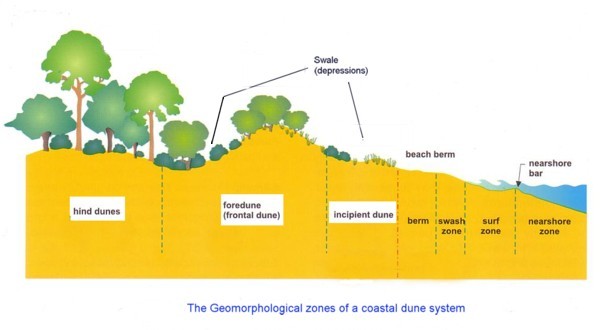
2.1 Geomorphological Processes
- The lithosphere and the processes that occur within it is the dominant sphere operating in the accretion cycle on Coastal Sand Dunes
- The significance of the lithosphere is demonstrated by the fact that the the name of this ecosystem, sand dune, is named after the lithosphere component rather than the dominant vegetation.
- The diagram below shows the different zones that make up the lithosphere on Coastal Sand Dunes.
The Geomorphological (the surface) Zones of a Coastal Dune System

- The major component that makes up the material for the accretion cycle to operate on Coastal Dune Systems is sand.
- One source of sand is calcium carbonatewhich comes from the shells of dead sea animals.
- However, the major source of sand is the material that has been weathered and eroded from rock elsewhere.
- The source originates from inland areas which is transported by rivers whilst the other source comes from coastal cliffs which are bombarded by waves and moved by currents.
- Thus, weathering and erosive processes that occur in the lithosphere are important functions in the development of Coastal Sand Dunes.
Geomorphological Processes- Weathering and Erosion
- Let's get our definitions right.Weathering is the breaking down of the lithosphere and erosion is the movement and depositing of the weathered material.
Weathering:
Why is mechanical weathering the predominant process on Coastal Sand Dunes?>
- As mentioned above sand is the major component in dune development. About 99.7% of the sand particles in dunes are inert quartz particles.This means that they are minerals that do not react chemically. Thus, most of the sand would have been weathered by mechanical means.
- The main mechanical weathering processes are hydraulic action and abrasion.
- Sand particles that originate from coastlines have strong waves act as powerful forces and bombard cliff faces with water, like high pressure hoses which loosen the sand particles (hydraulic action). Then the loosened particles act as sand paper and help loosen other particles like abrasive sand paper (abrasion)., These are transported by currents and deposited onto the beach.
- Furthermore, even when sand particles have been deposited on beaches and dunes, the mechanical weathering continues. While on the dunes the sand is further broken down by abrasion caused by wind and water making the sand particles even finer up the beach and behind the dunes. Wind carries other sand particles which act like sand paper and abrade other particles. The same happens with waves which has many sand particles in them and smash them onto other particles making sand particles even finer again.
Erosion
- Generally, it is through fluvial (water) erosion that the loosened material weathered is moved from its original (in situ) area.
- Fluvial processes such as river discharge, longshore drift, and wave action are part of the hydrosphere and will be covered in more detail there.
- In terms of the accretion cycle, powerful storm waves erode beach dune systems by moving large volumes of sand away from the beach and dunes..
- Another erosive process occurring on dunes is aeolian (wind) erosion. This process moves the particles of fine dry sand away from the shoreline. Wind can move whole dune systems inland.
- Historically the Hunter Catchment Area has provided the Stockton Coastal Sand Dune System with much of its sediment. The bedrock from mountain ranges around the area eventually are transported by the Hunter River and deposited.
- Furthermore, the Tomaree headland and other coastal cliffs south have contributed sand particles by being transported by a process called long shore drift (this will be covered in the hydrosphere section).